100
|
WILLIAM SEYMOUR
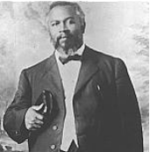
and the
AZUSASTREET REVIVAL
From Kansas in 1905, Charles Fox
Parham took a band of his protégés into Texas. There he preached,
distributed his The Apostolic Faith newspaper, won
converts, and set up a non-credit Bible school.
Parham’s Bible School in Houston, Texas
One of the students attracted to the
school was a former
waiter and southern Holiness preacher, William J. Seymour.
In the Jim Crow South, Seymour, a black, could take
part in the Bible studies only by sitting in the hallway
outside Parham's classroom.
After only a few weeks of
listening to Parham, Seymour received an invitation to
pastor a small Los Angeles church of Baptists expelled
from their congregation for espousing Holiness doctrines.
Seymour carried more than his luggage to California. He
boarded the steam train in the Houston depot with
enthusiasm and Parham's finely tuned statement of faith
The 35-year-old Seymour was
an unlikely ambassador of the Pentecostal message: he
was the son of slaves, not a gifted speaker, lacking in
social skills, had almost no formal education, and was
blind in one eye. But perhaps his greatest handicap was
the fact that he had never spoken in tongues, even
though he preached that such a sign should be a part of
every believer's experience.
He chose Acts 2:4 as the
text for his first sermon at the mission on Santa Fe
Street in Los Angeles: "And they were all filled
with the Holy Ghost, and began to speak with other
tongues, as the Spirit gave them utterance."
His message, that speaking in tongues was the
"Bible evidence" of baptism in the Spirit, was
well received by the congregation but not by the
pastor, Julia Hutchins. It is unclear how long
she let Seymour teach such things, but she soon
had the door padlocked shut against him.
Seymour and most of the congregation found an
open door for ministry in the Edward Lee home
where he was boarding. The Lees and a small
group had been praying for a another Great
Awakening, a Welsh-type revival that would turn
Los Angeles upside down. And they believed that
Seymour might be the catalyst.
When the Lee home grew too small for the
interracial crowd that gathered for Seymour's
Bible studies and prayer meetings, Richard and
Ruth Asberry opened their home at 214 (now 216)
North Bonnie Brae Street, even though they then
disagreed with some of his teaching.
On April 9,
1906, Edward Lee asked Seymour to pray for
him that he would be given the gift of
tongues. When Seymour prayed, Lee spoke in
tongues, fulfilling a vision he said he had
received in which the apostles taught him
how to speak in tongues.
Seymour immediately left for the
Asberry home Bible study and prayer meeting,
where he again preached from Acts 2:4 and
related Lee's experience. As he continued
his study, someone else began speaking in
tongues. Others followed. Jennie Moore,
Seymour's future wife, sat down at the piano
and improvised a tune while singing what she
thought was Hebrew.
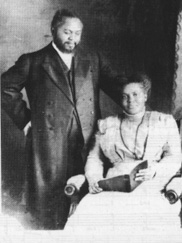
The meetings began at 10 a.m., and
continued for at least 12 hours, often
lasting until two or three the next morning.
Crowds of
both black and white faces descended on
the Asberry home over the next several
days. On April 12, the first white man
spoke in tongues. More importantly,
Seymour, "the prophet of Pentecost to
Los Angeles,"
finally received his
personal Pentecost.
And that
same day, the Asberry's front porch
gave way from the weight of the
crowds. That's when leaders
negotiated a lease for the former
Stevens African Methodist Episcopal
Church at 312 Azusa Street.
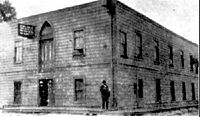
The
windows were knocked out. Debris
littered the floor. Its last
occupants had been livestock,
since it had most recently been
used as a stable.
It was more like the rustic
outdoor camps of the Holiness
movement than the
stained-glass churches of the
distrusted denominations. And
since it was not in a
residential area, meetings
could go all night.
Within a week, a makeshift
pulpit, altar, and benches
graced what the Times
reporter called the
"tumble-down shack" where
"colored people and a
sprinkling of whites"
practice the "most fanatical
rites, preach the wildest
theories, and work
themselves into a state of
mad excitement in their
peculiar zeal."
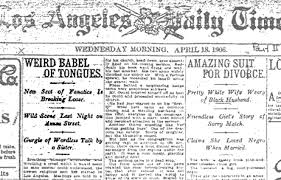
The article, published
almost immediately after
the group's move to the
new church, took Seymour
to task, too: "An old
colored exhort [he was
only 35], blind in one
eye, is the majordomo of
the company," the
reporter wrote. "With
his stony optic fixed on
some luckless
unbeliever, the old man
yells his defiance and
challenges
an answer. Anathemas are
heaped upon him who
shall dare to gainsay
the utterances of the
preacher."
Although he
knew the Pentecostal
teaching would be
controversial, Seymour
was adamant about what
he had learned and
experienced. The Holy
Spirit, he said, "will
find pure channels to
flow through, sanctified
avenues for his power….
You will never have an
experience to measure
with Acts 2:4 … until
you get your personal
Pentecost or the baptism
with the Holy Ghost and
fire."
Let the tongues come
forth!"
By
September the church
reported that about
13,000 people had
"received this
gospel. It is
spreading
everywhere, until
churches who do not
believe backslide
and lose the
experience they
have. Those who are
older in this
movement are
stronger, and
greater signs and
wonders are
following them."
Though
there were periods
of silence in the
meetings, where even
the most
demonstrative
believers sat still,
most of the meetings
were electric, loud,
and unlike the
services of "any
company of fanatics,
even in Los Angeles,
the home of almost
numberless creeds."
The meetings began
at 10 a.m., and
continued for at
least 12 hours,
often lasting until
two or three the
following morning.
"Elder" Seymour
rarely preached,
but when he did,
he would often
take out a tiny
Bible and read
only one or two
words at a time.
Then he would
walk the room,
challenging
unbelievers face
to face,
shouting to
those kneeling
at altars to
"let the tongues
come forth!" or
"Be empathetic!“
There were no
hymnals, no
liturgy, no
order of
services. Most
of the time
there were no
musical
instruments. But
around the room,
men jumped and
shouted. Women
danced and sang.
People sang
sometimes
together, yet
with completely
different
syllables,
rhythms, and
melodies. At
other times the
church joined
together in
English versions
of "The
Comforter Has
Come," "Fill Me
Now," "Joy
Unspeakable,"
and "Love Lifted
Me." At various
places, some
would be "slain
under the power
of God" or
entranced.
"Proud,
well-dressed
preachers
come in to
'investigate,'
" informed
The
Apostolic
Faith (a
newspaper
founded by
Seymour, not
to be
confused
with
Parham's
publication
of the same
name). "Soon
their high
looks are
replaced
with wonder,
then
conviction
comes, and
very often
you will
find them in
a short time
wallowing on
the dirty
floor,
asking God
to forgive
them and
make them as
little
children."
Depending on
the
observer,
the
occurrences
were either
proof of
God's
presence or
of the
participants'
fanaticism.
But to all
witnesses,
it was
something
new.
'You-oo-oo
gou-loo-loo
come
under
the
bloo-oo-oo
boo-loo,'
shouts
an old
colored
'mammy'
in a
frenzy
of
religious
zeal,"
reported
the
skeptical
Times.
"Swinging
her arms
wildly
about
her, she
continues
with the
strangest
harangue
ever
uttered."
Despite
the
frequent
critical
news
reports,
the
curious
and
genuine
seekers
continued
to pour
down
Azusa
Street.
"The
secular
papers
have
been
stirred
and
published
reports
against
the
movement,"
boasted
the
first
issue of
The
Apostolic
Faith.
"But it
has only
resulted
in
drawing
hungry
souls
who
understand
that the
Devil
would
not
fight a
thing
unless
God was
in it."
In fact,
when the
Times
printed
a
speaker's
prophecy
of
"awful
destruction"
the day
of the
San
Francisco
earthquake,
many
residents'
interest
was
piqued.
One
striking
feature
of
the
early
meetings:
they
were
interracial.
Although
Los
Angeles
was
not
segregated
by
law,
it
was
unusual
in
the
growing
city
of
230,000
to
see
blacks,
whites,
Hispanics,
Asians,
and
newly
arrived
European
immigrants
worshiping
under
the
same
roof.
A
1906
Azusa
staff
photo
shows
blacks
and
whites,
men
and
women—all
in
leadership.
An
unsigned
article
in
the
November
1906
issue
of
The
Apostolic
Faith
said,
"No
instrument
that
God
can
use
is
rejected
on
account
of
color
or
dress
or
lack
of
education."
Another
described
one
Communion
service
and
foot
washing
that
lasted
until
daybreak:
"Over
twenty
different
nationalities
were
present,
and
they
were
all
in
perfect
accord
and
unity
of
the
Spirit."
Though reports of the miraculous were sometimes exaggerated, the church didn't mask the revival's problems. Seymour wrote several letters to Parham asking advice in dealing with spiritualists and mediums from occult societies, who were trying to conduct séances in the services. And the church publicly admitted that not everyone at the meetings felt the presence of the Spirit:
“ While some in the rear are opposing and arguing, others are at the altar falling down under the power of God and feasting in the good things of God. The two spirits are always manifest, but no opposition can kill, no power in earth or hell can stop God's work."
A future general superintendent of the Assemblies of God, Ernest S. Williams, drawn to Azusa Street from Denver, was turned off by the more fanatical elements, but he also sensed vitality:
"On the brink of turning away," he said, "a great check came over my spirit. Then I began to seek earnestly."
Chicago pastor William Durham was also somewhat skeptical of the meetings, having heard conflicting reports, but he reported, "As soon as I entered the place, I saw that God was there."
Many of the thousands who poured into 312 Azusa Street between 1906 and 1909 heard the revival news through the widely circulated The Apostolic Faith. The paper not only kept readers abreast of what was happening in the "City of Angels" but also in churches and mission stations around the world.
Whether the seekers read the paper or came in person, they were certain to receive messages emphasizing repentance, salvation, humility, worship, healing, deliverance from demonic possession, holy living, and the baptism in the Holy Spirit
Divisions and the end
Along with the success, hurts and heartaches soon came to Azusa Street. Seymour and the faithful learned to expect criticism from newspapers and leaders of other churches—including the founder of the Pentecostal Church of the Nazarene, P. F. Bresee, who believed that Holiness people were already baptized in the Holy Spirit and that the Azusa tongues were not from God.
But some of the harshest criticism came from inside the little mission, with the mother church splitting because of personality clashes, fanaticism, doctrinal differences, and racial separation.
It was said that some whites left because the blacks had a lock on the leadership. Seymour, proving that he was no more perfect than his critics, reportedly asked the Hispanics to leave, and later wrote by-laws that prevented anyone except African-Americans from holding office in the mission. The often-quoted line that "the color line was washed away in the blood" was true in practice for only a short time.
Through the early months of the revival, Seymour gave credit for the movement's origins to Charles Parham and said that Azusa was an extension to the Midwest Apostolic Faith. Expecting a visit from Parham, Seymour wrote, "He was surely raised up of God to be an Apostle of this doctrine of Pentecost." But that "grand meeting" of October 1906 ended in a division that never fully healed.
Parham was shocked at what was being called spiritual manifestations. At what Seymour viewed as God-sent, Parham cringed with disgust, even labeling some adherents as spiritists.
|
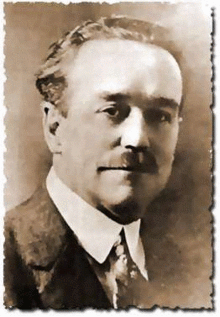
|
"I sat on the platform in Azusa Street Mission, and saw the manifestations of the flesh, spiritualistic controls, [and] saw people practicing hypnotism at the altar over candidates seeking the baptism, though many were receiving the real baptism of the Holy Ghost. After preaching two or three times, I was informed by two of the elders, one who was a hypnotist…that I was not wanted in that place."
|
But though the founder and most prominent leader of Pentecostalism renounced it, Azusa Street eclipsed him as the center of the new movement.
|
y1849 –Sister White’s Vision
As we here read what Charles Fox Parham saw with his own eyes as he sat on the platform at the Azusa Street Mission – the hypnotism being practiced, some even from the pulpit, the outright Spiritism in the room along with what he saw as legitimate manifestations of the Holy Spirit also being practiced, along with an ongoing debate in the back of the room. As another noted “While some in the rear are opposing and arguing, others are at the altar falling down under the power of God and feasting in the good things of God. The two spirits are always manifest, but no opposition can kill, no power in earth or hell can stop God's work.“
We can be certain that indeed Ellen White had also seen in vision these very meetings, with all their flaws and shortcomings about 50 years before they occurred!
|
After some three years of daily, high intensity revival meetings, the Azusa Street Revival, still under Seymour's leadership, began winding down. When the crowds fell off, the mission soon looked like many other Pentecostal missions sprouting up in the Los Angeles area, with only sparse attendance.
Eventually, after Seymour's death in 1922 and his wife's in 1936, the mission closed and was razed. Only memories were left. But a new chapter in the history of the church had begun.
—Ted Olsen is assistant editor of Christian History. His principal source for this article was an unpublished manuscript by Wayne Warner, director of The Flower Pentecostal Heritage Center in Springfield, Missouri.
|
NEXT WEB PAGES IN SERIES:
On November 8, 2014 Pastor Erin Miller of the Foster
Seventh-day Adventist Church recognized some similarities of her fellow
church members with the 400 persons who gathered to meet the fleeing David
at the Cave of Adullam.
For Dr. Bob Holt's account--
Click Here!
or, if you prefer skip these pages for now and go
directly to
David's Dance before God's Holy Ark!
Quit and
Return to Main Index |
|